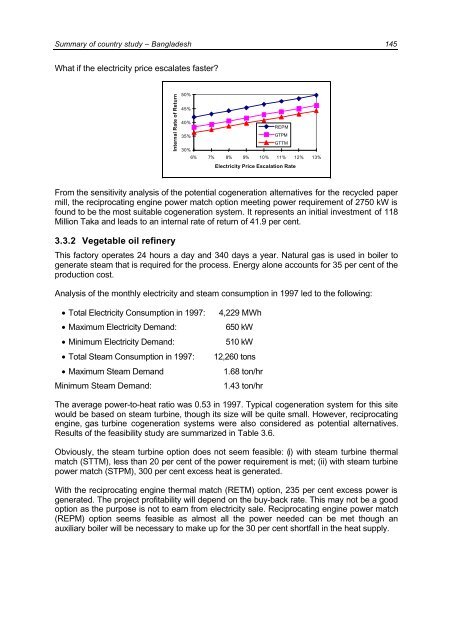part 1: overview of cogeneration and its status in asia - Fire
part 1: overview of cogeneration and its status in asia - Fire
part 1: overview of cogeneration and its status in asia - Fire
You also want an ePaper? Increase the reach of your titles
YUMPU automatically turns print PDFs into web optimized ePapers that Google loves.
Summary <strong>of</strong> country study – Bangladesh 145<br />
What if the electricity price escalates faster?<br />
Internal Rate <strong>of</strong> Return<br />
50%<br />
45%<br />
40%<br />
35%<br />
30%<br />
REPM<br />
GTPM<br />
GTTM<br />
6% 7% 8% 9% 10% 11% 12% 13%<br />
Electricity Price Escalation Rate<br />
From the sensitivity analysis <strong>of</strong> the potential <strong>cogeneration</strong> alternatives for the recycled paper<br />
mill, the reciprocat<strong>in</strong>g eng<strong>in</strong>e power match option meet<strong>in</strong>g power requirement <strong>of</strong> 2750 kW is<br />
found to be the most suitable <strong>cogeneration</strong> system. It represents an <strong>in</strong>itial <strong>in</strong>vestment <strong>of</strong> 118<br />
Million Taka <strong>and</strong> leads to an <strong>in</strong>ternal rate <strong>of</strong> return <strong>of</strong> 41.9 per cent.<br />
3.3.2 Vegetable oil ref<strong>in</strong>ery<br />
This factory operates 24 hours a day <strong>and</strong> 340 days a year. Natural gas is used <strong>in</strong> boiler to<br />
generate steam that is required for the process. Energy alone accounts for 35 per cent <strong>of</strong> the<br />
production cost.<br />
Analysis <strong>of</strong> the monthly electricity <strong>and</strong> steam consumption <strong>in</strong> 1997 led to the follow<strong>in</strong>g:<br />
• Total Electricity Consumption <strong>in</strong> 1997: 4,229 MWh<br />
• Maximum Electricity Dem<strong>and</strong>: 650 kW<br />
• M<strong>in</strong>imum Electricity Dem<strong>and</strong>: 510 kW<br />
• Total Steam Consumption <strong>in</strong> 1997: 12,260 tons<br />
• Maximum Steam Dem<strong>and</strong> 1.68 ton/hr<br />
M<strong>in</strong>imum Steam Dem<strong>and</strong>: 1.43 ton/hr<br />
The average power-to-heat ratio was 0.53 <strong>in</strong> 1997. Typical <strong>cogeneration</strong> system for this site<br />
would be based on steam turb<strong>in</strong>e, though <strong>its</strong> size will be quite small. However, reciprocat<strong>in</strong>g<br />
eng<strong>in</strong>e, gas turb<strong>in</strong>e <strong>cogeneration</strong> systems were also considered as potential alternatives.<br />
Results <strong>of</strong> the feasibility study are summarized <strong>in</strong> Table 3.6.<br />
Obviously, the steam turb<strong>in</strong>e option does not seem feasible: (i) with steam turb<strong>in</strong>e thermal<br />
match (STTM), less than 20 per cent <strong>of</strong> the power requirement is met; (ii) with steam turb<strong>in</strong>e<br />
power match (STPM), 300 per cent excess heat is generated.<br />
With the reciprocat<strong>in</strong>g eng<strong>in</strong>e thermal match (RETM) option, 235 per cent excess power is<br />
generated. The project pr<strong>of</strong>itability will depend on the buy-back rate. This may not be a good<br />
option as the purpose is not to earn from electricity sale. Reciprocat<strong>in</strong>g eng<strong>in</strong>e power match<br />
(REPM) option seems feasible as almost all the power needed can be met though an<br />
auxiliary boiler will be necessary to make up for the 30 per cent shortfall <strong>in</strong> the heat supply.









